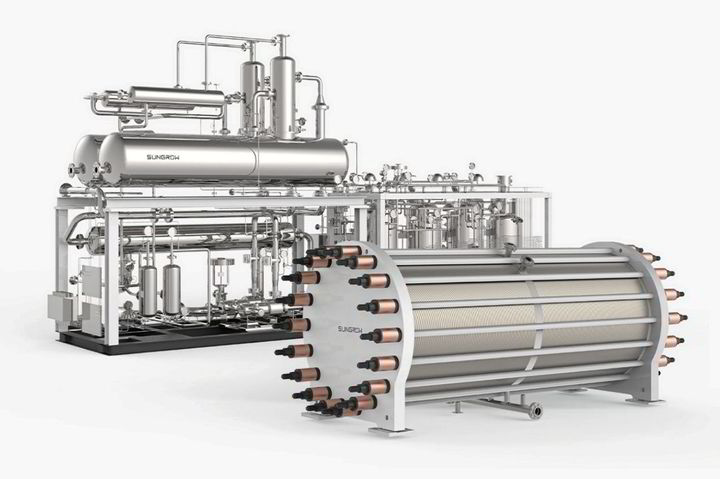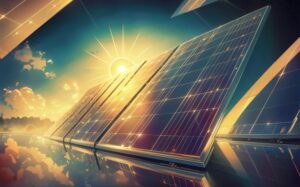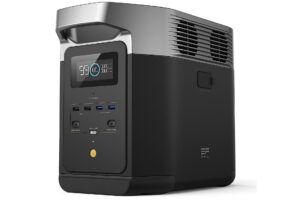Auction results reveal that Chinese hydrogen electrolysers are two to five times cheaper to buy than Western machines

Fourteen Chinese manufacturers have been selected as winners in what is believed to be China’s largest ever public electrolyser tender, with the auction holder, state-owned China Energy Engineering Group (also known as Energy China) publicly revealing the winning bid prices — offering rare public insight into the cost of the machines.
Eleven manufacturers won with bids for 5MW alkaline electrolysers averaging around ¥7.5m ($1.05m) each — $210,000 per MW — while five OEMs were chosen for their 1MW PEM machines, which cost an average of about ¥ 5.67m ($630,000) each (see table below for details).
| Manufacturer | Type | Price ($) |
| Sungrow Hydrogen | ALK (5MW) | 961,504 |
| Wuxi Huaguang | ALK (5MW) | 992,758 |
| Guangdong Shengqing | ALK (5MW) | 994,830 |
| Trina Solar Hydrogen | ALK (5MW) | 1,004,681 |
| Beijing Power Equipment Group | ALK (5MW) | 1,041,786 |
| Tianjin Mainland Hydrogen | ALK (5MW) | 1,053,900 |
| Shanghai Electric | ALK (5MW) | 1,072,423 |
| Cockerill Jingli Hydrogen | ALK (5MW) | 1,081,812 |
| Shuangliang Group | ALK (5MW) | 1,090,042 |
| Peric | ALK (5MW) | 1,100,000 |
| Longi Hydrogen | ALK (5MW) | 1,112,256 |
| Shanghai Electric | PEM (1MW) | 484,680 |
| Sungrow Hydrogen | PEM (1MW) | 567,209 |
| BriHyNergy | PEM (1MW) | 626,741 |
| SPIC Hydrogen | PEM (1MW) | 728,858 |
| Cummins Enze | PEM (1MW) | 750,418 |
Energy China — which has begun construction of what will be the world’s largest green hydrogen project, using 640MW of electrolysers — said: “This bidding is for the procurement of hydrogen production equipment required for projects invested [in] or constructed by enterprises affiliated to the joint-stock company from December 2023 to November 2024. The total estimated quantity is 125 sets.”
Hydrogen Insight understands that the procurement will be split between 25 PEM electrolysers and up to 100 alkaline machines, although the total wattage, the individual allocation between manufacturers, and the projects where the electrolysers will be used have not yet been revealed.
All the winning manufacturers are based in China and owned by Chinese companies, with the exception of Cockerill Jingli, which is 100%-owned by Belgium’s John Cockerill, and Cummins Enze, which is a 50/50 joint venture between US-based Cummins and Chinese oil giant Sinopec.
As Hydrogen Insight revealed earlier this week, alkaline electrolysers manufactured by Cockerill Jingli, Peric and Longi have been underperforming at the world’s current largest green hydrogen project, Sinopec’s 260MW Kuqa facility in Xinjiang, northwest China.
Article continues below the advert
How do the prices compare with Western electrolysers?
Understandably, electrolyser makers rarely make public their asking prices, and only reveal them during negotiations with potential buyers under non-disclosure agreements.
They are also wary of comparing apples with oranges, as different electrolysers have different efficiencies, operating ranges, current densities and lifetimes, so comparing upfront cost alone is not particularly helpful in understanding the true levelised cost of hydrogen (LCOH) production.
Indeed, more expensive electrolysers are said to offer lower LCOH over project lifetimes than the cheapest machines.
Nevertheless, some organisations have published what they believe to be the average cost of electrolysers.
In a report from February, financial consultant EY put the average cost of alkaline electrolysers at $700-1,100 per kW ($700,000-1.1m per MW) — around three to five times higher than the average $210,000 per MW in the Energy China tender.
And it put the average cost of PEM electrolysers at $1,200-2,000 per kW ($1.2-2m/MW) — more than double the average $630,000/MW at the Chinese auction.
The International Energy Agency says the current average price of alkaline electrolysers is $500,000-1.4m/MW, with PEM at $1.1-1.8m/MW.




